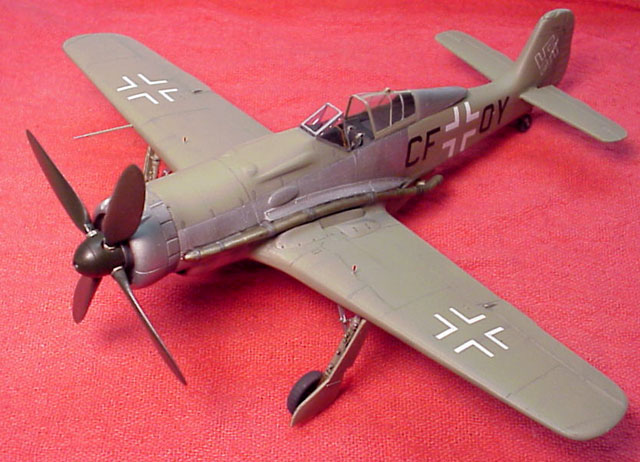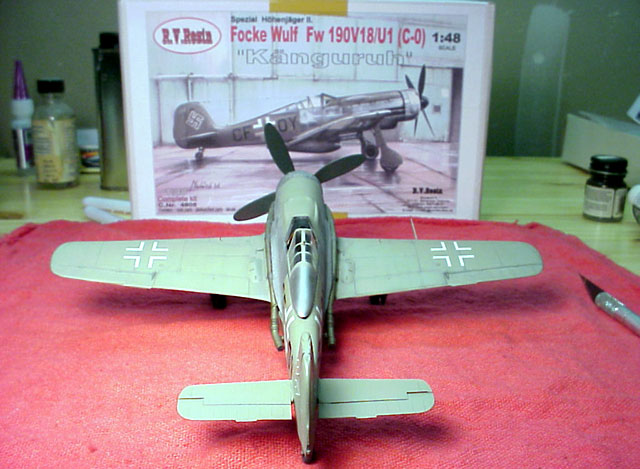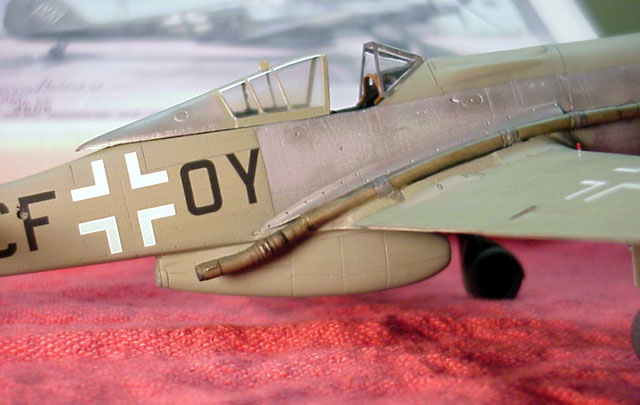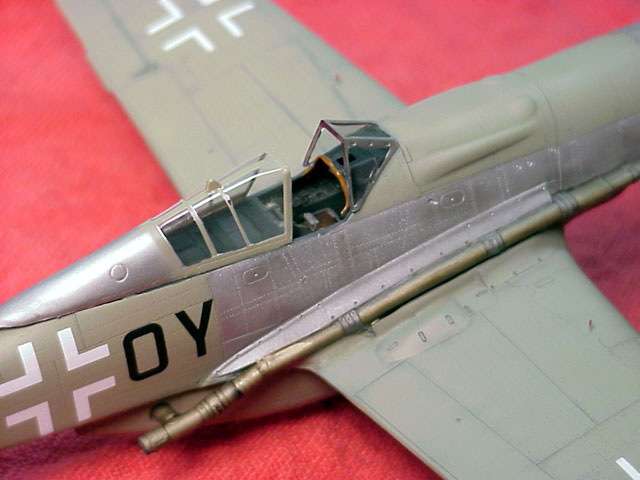|
Focke-Wulf Fw 190 V18
by Allan Wanta
|

|
|
Focke-Wulf Fw 190 V18 "Kangaru" |

HyperScale is proudly supported by
Squadron
Staring in 1942-43, many German officials believed
the Allies would be introducing high altitude bombers such as the B-29,
something the Third Reich could not defend against effectively. The Me-109
had limitations as did the early Fw-190ís, so bothe companies started
development programs for the Hoehenjager fighter contract. Many older
Fw-190 airframes were modified again and again to find the right
combination of wings, turbo chargers, tail surfaces and the such to fill
this requirement. In the end, the TA-152 won out as the overall winner,
but the road to the final product is sown and littered with unusual
aircraft, this V18 is one of them. The standard airframe was given a
Damiler Benz 601 engine, and slung below the fuselage was a supercharger.
Tubes and pipes ran hot air back to the engine for improved high altitude
performance giving the airplane an unfinished appearance. Problems with
metals used in the supercharger put an end to the eventual development of
this particular project.
R.V. Resin's
1/48 Scale Fw 190 V18
|
This is great, a kit of one of the coolest experimental aircraft the
Germans ever made, and itís made by whom? RV Resins you fools, you know,
the guy out in the Czech Republic with the magnifying glass spectacles. I
swear the surface detail on the wings and fuselages is perfect and exactly
like the original airframe. Every rivet and panel is superbly reproduced
in scale, better than anything Iíve ever scene. Now mind you, this is
coming from the guy whoís made some really weird stuff out of some mighty
dicey kits.

The kit is packaged in a sturdy Grey cardboard two piece box with nice
artwork, all parts are heat sealed in their own little pouch-o-plastic
bubble and none of the parts are twisted, broken or warped. A single
exploded view assemble sheet with paint guide is the only form of
reference for you, but, if youíve built one FW-190, youíve built them all.
Well, donít get your Hanes in a bundle, cause in most cases thatís true,
letís face it. Decals, metal landing gear and a clear vac canopy round out
the players.
Little sanding is need in prepping the fuselage
halves, lightly sand each half just to make sure any burrs are removed.
But to tell you the truth, you wonít need much, only a few pour blocks are
present, and then on some lesser parts. I did have one particular question
after the two halves were glued, mine has an abnormally wide tail
cross-section. Seems to me the tail fin and rudder are thinner than other
190ís Iíve done. I have an aftermarket set for the Tamiya 190, rudder and
elevators, and itís definitely are thinner than the rudder on the kit.
Perhaps some more rubbing on the tail area next time, cause I know my
cockpit tub fits perfect already so no need to sand the front half. It
just looks, thick and not very sleek for a fighter.
As mentioned, the cockpit tube inserts through the
wing cavity and lines up with placement lines scribed in the fuselage.
With the resin control panel in place, I might suggest it coming up about
1 or 2 mm as it seems to sit low. Itís a simple affair, detail is great
but many might like to spruce it up with an after market detail set. But
since Iíve planned to make this an Out of Box kit, I left it alone.

Now comes the wing, 3 pieces thin as paper, trailing edge sharp enough to
cut bread, very nice. The ailerons are well defined, almost can see
through the separation line, wonít take much to remove them with one swipe
of a number 11 exacto blade. Now thatís casting! The wheel wells go in and
line up with scribed lines, as the tops fit equally well on the lower
wing. Not a lot of problems until the wing fit to the fuselage. I may be
the culprit and have sanded my fuselage pieces a hair too much, because
the gaps on the wing roots are a bit much. Another quest is the general
lack of Dihedral; itís going to take some quick super gluing to fit this
one. But I managed to get some semblance of dihedral as well as bridging
the gaps at both roots. The seams will be less noticeable as they end up
under the exhaust pipes running to the back of the plane. But it looks as
though a bit more dihedral is needed.
Another issue came up with the two rear stabilizers, and it looks like a
very amateur mistake on RV Resins part. After I sanded the stabilizers
from their mold blocks, both were offered up to their respective
locations, and what do I see. One sits higher on the empainage that the
other when viewed from the front. Also the elevator actuating rods which
normally run into the tail are very much missing. Itís just as well as the
holes for them are well misplaced. This is probably the one thing people
will notice the most if this kit sits next to another Tamigawa 190. Some
fudging and putty cured the location error, but the holes are still in the
wrong spot leaving that area a bit lacking for detail. Compound the wide
cross section tail and mis-located Stabilizers, it will require much work
when I build another one of these kits.
On to the cowling. A very different looking cowling by FW-190 standards
almost looks as though it is short shot when cast. The casting looks
incomplete, missing a good edge on the back of the cowl flaps this area in
turn mates to the fuselage. No sanding was done here, I needed all cowl I
could get and in the end actually looks O.K. There is a bit of photo-etch
that goes into the front of the cowl to replicate the radiator grills
along with a bit that the spinner eventually glues to, itís important to
place this resin piece properly.
After a trip to the local hobby store in Santa Barbara, I picked up a
Tamiya FW-190 kit, it seems the folks at RV forgot to put in the two
landing gear actuating arms and I wanted to finish the kit earlier than
later. Low and behold I noticed a strange similarity between many of the
castings in the RV kit and the plastic pieces of the Tamiya kit. They are
one and the same! The fuselage of course is a new casting, but all the
other bits and pieces have been borrowed from the Japanese kit. I guess RV
Resins had to start somewhere, and they certainly chose the best kit to
modify. Again, I think the surface detail is clearly the best
representation Iíve ever seen on the resin parts, but more detailing in
the cockpit wouldnít have been a bad idea. By the way, Dave Cooper who is
the USA importer of R.V. Resin kits notified me that replacements are
already on the plane, I thank Dave for following up and rectifying the
situation.
 Well, now comes that RLM 02 and aluminum paint finish
the original plane had. Seeing that only one color option is available for
this kit, it might limit the overall appeal. I on the other hand couldnít
wait to give my representation a shot. The aluminum was sprayed first,
Testors metaliser, and then masked with Testors RLM 02 Grey sprayed next.
Simple and neat. After all was painted and prepped for the decals did I
notice I had reference material on the prototype 190ís. According to those
references, the paint scheme in the directions is a bit off, but close
enough for Government work. You should have some pictures and such before
going into this or any other kit just in case, or you might get stopped by
the dread modeling police at your next show or meeting. Well, now comes that RLM 02 and aluminum paint finish
the original plane had. Seeing that only one color option is available for
this kit, it might limit the overall appeal. I on the other hand couldnít
wait to give my representation a shot. The aluminum was sprayed first,
Testors metaliser, and then masked with Testors RLM 02 Grey sprayed next.
Simple and neat. After all was painted and prepped for the decals did I
notice I had reference material on the prototype 190ís. According to those
references, the paint scheme in the directions is a bit off, but close
enough for Government work. You should have some pictures and such before
going into this or any other kit just in case, or you might get stopped by
the dread modeling police at your next show or meeting.

Decals are some of the best-made, thin, strong and very glossy. There are
no complaints about them from me, didnít even have to use setting
solutions.
There we have it, a Fw-190-V18, and a darn good one it is. A few glitches
that we might normally associate with resin kits, but this one is far and
away one of the easiest to get together. With that in mind the Fun-O-Meter
lists at a 9, with a Cool factor almost pegged out at 9.5. Generally
speaking anyone who has made a few plastic kits with resin bits could have
a good time with this one. This is an honest review as I bought this kit
with my own money.
Model, Images and Text Copyright © 2003
by Allan Wanta
Page Created 26 March, 2003
Last Updated
17 March, 2004
Back to
HyperScale Main Page |
Home |
What's New |
Features |
Gallery |
Reviews |
Reference |
Forum |
Search